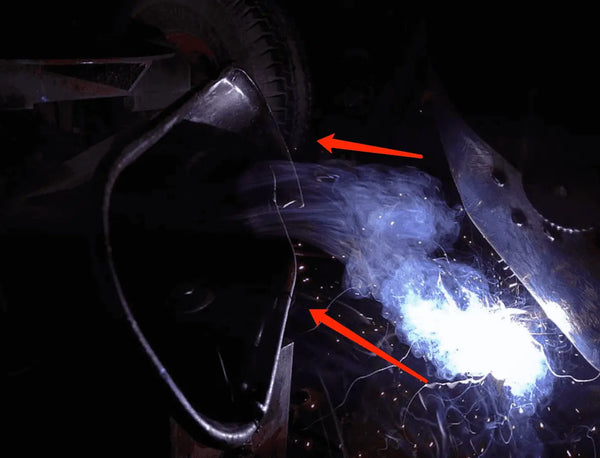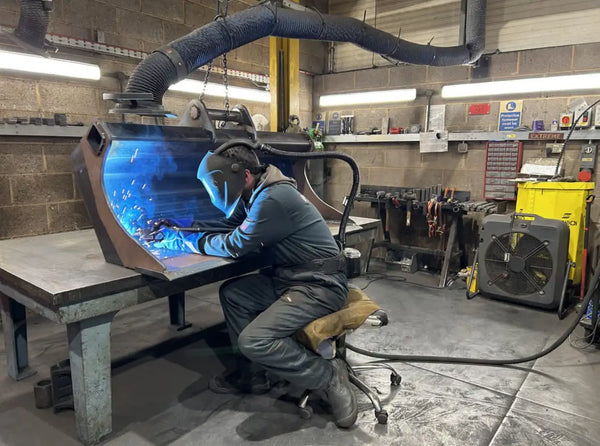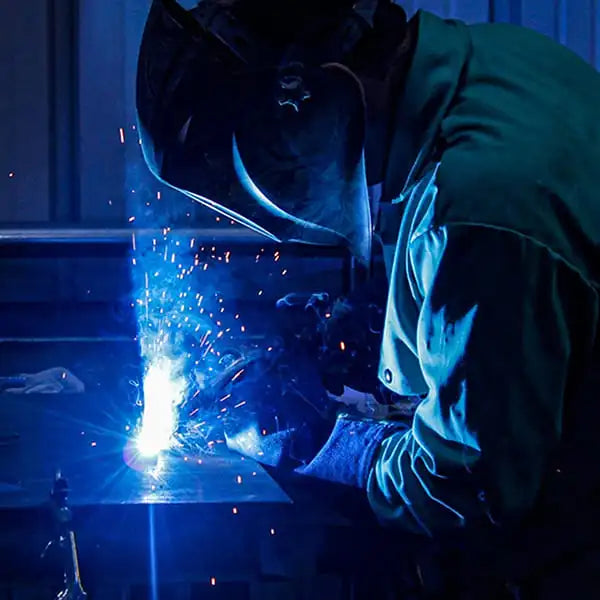Welding Fume Dangers And How To Protect Yourself
Welding is a dangerous job, no doubt about it. But, some welding hazards are more challenging to spot than others. While you would immediately assume that getting arc flashed is bad for your eyes, welding fume inhalation may not be as obvious of a health hazard.
Other than electrocution and burns, welding fumes are probably the most dangerous welding hazard. In fact, some welding fumes are so hazardous that all it takes is just one inhalation, and you are a goner with a slim chance of survival. Luckily, such fumes aren't prevalent. But that doesn't mean that other fumes won't cause severe immediate or chronic health maladies.

Thankfully, with some safety precautions, your chances of breathing in toxic fumes are minimal.
So, let's dissect the welding fume hazards in detail and show you the ways to protect yourself.
Why Are Welding Fumes Dangerous
Let's get one thing sorted right off the bat: there are no safe welding fumes. All welding fumes are dangerous. It's just that some are far more hazardous than others.
Welding, obviously, melts the base and filler metals along with any fluxes (when using flux-cored wires or stick rods). As metals melt and fluxes burn, tiny amounts of the metal and flux compounds evaporate into the air, and we call these the "welding fumes" or "plume." Usually, metals evaporate into oxides, like aluminum oxide, zinc oxide, and others, but some metals form other types of compounds as they mix with air.
Electrodes, like stick rods and even MIG wires, can contain dangerous elements like fluorides, silica, and manganese.
As CDC reports, welding fumes are now classified as Group 1 cancerogenic by the International Agency for Research on Cancer (IARC) based on strong epidemiological evidence and limited evidence in animals.
This study showed that even the basic iron oxide Fe2O3 originating from welding mild steel poses a risk for developing lung cancer.
Other than cancer, many welding fume compounds can contribute to chronic health issues like heart disease, nervous system damage, skin issues, kidney and liver problems, and other health maladies.
Luckily, most of these can be avoided with proper safety procedures and equipment, which we'll discuss at the end of this article. Let's now focus on individual toxic fumes and metals.

Are All Welding Fumes Equally Hazardous?
No. Not all welding fumes are equally dangerous, but all pose some risk to your health. So, you should never become complacent, even when welding less hazardous metals.
Below is a table showing the most dangerous fumes and their sources. But, before you look at a table, let's discuss phosgene because it has a unique source.
Phosgene is the most dangerous welding fume compound you can get exposed to. Inhaling phosgene can be fatal, and even if survived, phosgene leaves debilitating consequences.

The UV radiation from the welding arc can react with the vapors from chlorinated hydrocarbon degreasing solvents (e.g., trichloroethylene, TCE) to form phosgene. So, you should never use brake cleaners or other types of chlorinated hydrocarbons to pre-clean the welded joint. In addition, never weld in the area where there are active VOCs from degreasers, solvents, paints, wood varnishes, and other types of chemicals that can contain chlorinated hydrocarbons.

|
Fume Type |
Source |
Associated Health Hazards |
|
Hexavalent chromium |
Stainless Steel |
Lung cancer, skin irritation, kidney, liver, and lung damage. |
|
Cadmium Oxides |
Cadmium-plated steel or cadmium alloys |
Kidney damage, cancer, chest pains, and respiratory system damage. |
|
Iron Oxides |
Mild steel and iron |
Lung siderosis, cancer, and airway irritation. |
|
Lead |
Lead and lead alloys like bronze and brass |
Severe brain and nervous system damage, kidney and digestive system issues, and reduced mental capacity. |
|
Molybdenum |
Iron, steel alloys, and nickel alloys |
Shortness of breath, airway irritation, and eye damage. |
|
Zinc Oxides |
Galvanized steel |
"Metal Fume Fever," with symptoms resembling a strong respiratory infection. |
|
Manganese |
Hadfield steel, high-strength steels, and many welding electrodes |
Neurological issues, lung damage, kidney, and liver damage, and tremors. |
|
Fluorides |
Electrode coatings |
Bone and joint problems and excessive lung fluid. |
|
Beryllium |
Copper, aluminum, magnesium, and beryllium alloys |
Cancer, chronic and acute beryllium disease, skin lesions, and lung issues. |
|
Aluminum |
Aluminum alloys and various alloys containing aluminum |
Aluminosis, brain diseases, and lung problems like COPD. |
* The table above outlines some of the associated diseases. Please read the full breakdown below to see the hazard details of each dangerous metal.
The Most Dangerous Metals To Weld
Since all metals pose a respiratory welding hazard, you should have a good understanding of the associated dangers. In fact, OSHA mandates that all welders and other workers in the shop are informed of the hazards they may be exposed to. While DIY and hobby welders won't inhale nearly as many fumes as professional welders, everyone should understand the risks and protect themselves accordingly.

Cadmium-plated Steel And Cadmium Alloys
Cadmium is sometimes used as a plating material to prevent steel from corrosion. While its use is heavily regulated nowadays, you can still stumble upon cadmium-plated steels.
Cadmium is a highly hazardous metal that has no business inside any biological being, humans included. It destroys the environment wherever it leeches into the waterways. It's a non-biogenic element, meaning that it serves no biological function. Cadmium is just bad news all around, so you do not want to inhale it.
After inhalation, cadmium deposits in the bones and takes a long time to be expelled by the body.
Some of the most prominent cadmium-related health hazards are:
- Respiratory illnesses, often with severe symptoms
- Lung cancer
- Chronic kidney damage that can lead to complete kidney failure
- Bone damage
- High concentrations can cause death

Stainless Steel
Stainless steel is a beautiful metal with even more beautiful welds if done right. It's a perfect metal for interior details and car parts like exhaust pipes. But, welding stainless steel produces hazardous fumes that shouldn't be inhaled.
During welding, stainless steel produces hexavalent chromium in the fumes, which is a cancerogenic compound. In addition, stainless steels often contain large amounts of nickel, which is also cancerogenic.

Inhaling stainless steel welding fumes is associated with the following:
- Respiratory irritation and diseases
- Cancer
- Asthma
- Lung damage
- Skin issues
- Nasal ulcers
Lead And Lead-based Alloys
Lead is a highly toxic compound that should never be introduced into your body, especially not through fume inhalation. Welding lead and lead-based alloys pose a severe health hazard.
While most people never need to weld lead, as a hobby DIY welder, you may think about welding brass or bronze (both contain lead). In that case, you must follow all respiratory safety precautions, which we'll discuss at the end of the article.

Fumes from lead and its alloys are associated with:
- Anemia
- Lowered mental capacity and clarity
- Lead poisoning
- Brain damage
- Central nervous system illnesses
- Kidney damage
- Impaired fertility
- Increased chance of having children with disabilities, even if only one partner was exposed to lead
Manganese Steel
Steel alloys that contain manganese can expose you to this harmful chemical. But, most welding electrodes contain manganese, so you can breathe it in even if the steel doesn't have a significant amount of manganese.

Breathing in fumes with manganese has been linked to the following health issues:
- Metal fume fever symptoms (resemble severe flu symptoms)
- Kidney and liver damage
- Neurological issues
- Reduced hand-eye coordination
- Brain and central nervous system damage
- Tremors and poor balance
- Negative impact on the reproductive system
Nickel Alloys
Welding nickel alloys like stainless steel and Inconel produces nickel-contaminated welding fumes. Nickel can increase your risk of cancer, but it's also associated with:
- Respiratory diseases
- Skin issues
- Acute airways irritation
Galvanized Steel
If you've never experienced welding fume fever, you probably never welded galvanized steel without respiratory protection. If that's you, let's keep it that way! But, if you know what welding fume fever feels like, you've probably sworn never to weld galvanized again!

Photo by @dr.weldz (Ins)
Galvanized steel has a zinc coating, which prevents corrosion. However, this zinc coating evaporates during the welding process into fumes that contain zinc oxides, which can produce acute flu-like symptoms, also known as metal fume fever or welder's fever.
Welding galvanized steel is safe if you grind off the zinc coating in and around the welded joint. Likewise, you must wear an appropriate respiratory mask, but we'll get to the safety tips in a bit.

Metal fume fever produces the following symptoms:
- Thirst
- Caugh
- Throat and nose irritation
- Congestion
- Body pains
- Shivering
These symptoms can persist for days. Sometimes, there can even be a lag period between zinc oxide inhalation and the appearance of symptoms.
Beryllium
If you weld beryllium alloys, chances are that you are a professional welder who knows all about the dangers of welding fumes. That's because these alloys are most commonly used by the defense, nuclear, aerospace, and medical industries. So, not something you would weld as a DIY project. But, beryllium alloys can often be with aluminum, copper, nickel, or magnesium.

So, if you ever need to weld metals that contain beryllium, keep in mind that it's associated with the following diseases:
- Lung cancer
- Skin lesions
- Chronic and acute beryllium disease
- Fatigue
- Pulmonary fibrosis
- Pneumonitis
Aluminum
Almost every welder wants to master welding aluminum. It's a fascinating metal to work with and can be used to lighten the construction or provide its corrosion resistance and excellent aesthetics.

But, welding aluminum also produces dangerous fumes. So, you should wear a respiratory mask whenever working with this metal.
Aluminum fumes are associated with these conditions:
- Asthma
- Chronic bronchitis
- Chronic obstructive pulmonary disorder
- Nerve and brain diseases
- Aluminosis, an incurable lung disease
How To Protect Yourself From Welding Fumes
Since you are unlikely to know the alloy composition of every metal you'll ever weld, or the composition of all stick rods, FCAW, and MIG wires, you should treat all welding jobs as hazardous.
Thankfully, it's easy to protect yourself from the welding fumes.
All you have to do is to weld outdoors whenever possible and wear a suitable respiratory mask.
When welding indoors, please make sure you have adequate ventilation. Welding shops and fabrication businesses must actively measure the level of hazardous fumes in the work area and employ various mechanical fume extraction and ventilation systems. As a hobbyist, you should ensure maximum welding protection as you can, and always abide by your local laws and regulations regarding welding fume safety.

If you often weld indoors, it may be worthwhile to buy a portable fume extraction system or make a DIY ventilation system that expels the fumes outdoors.
But, at the very minimum, you should always wear an appropriate welding respirator.
While welding fume hazard is usually evaluated for professional welders who weld 8-hour shifts, even a hobbyist shouldn't be exposed to any unnecessary risks. Welding respirators are inexpensive and are durable enough to complete various DIY projects.
So, if you weld outdoors whenever possible and use a respirator, you will significantly reduce exposure to hazardous fumes.

Conclusion
While there are no safe welding fumes, it's relatively easy to protect yourself. Professional welders must wear various respiratory protection devices (including PAPR) or rely on mechanical fume extraction. But, even if you don't weld all day, it's recommended to weld outdoors and wear a respirator.
Don't forget to protect yourself when TIG welding too. While MIG, stick, and flux-cored welding processes produce the most fumes, TIG is not harmless. While less obvious, TIG welding produces the same or similar amount of fumes (depending on the metal), and you should protect yourself accordingly. In fact, TIG welding stainless steel or aluminum can produce additional Ozone because the arc is so clean and the metals are reflective. Ozone is a carcinogen too. So, don't assume that if there aren't many visible fumes that it's safe to breathe them, especially indoors.
🧐Welding Fume Dangers And How To Protect Yourself - FAQ
1. What is the most dangerous metals to weld?
Galvanized steel has a zinc coating, which prevents corrosion. However, this zinc coating evaporates during the welding process into fumes that contain zinc oxides, which can produce acute flu-like symptoms, also known as metal fume fever or welder's fever.
Welding galvanized steel is safe if you grind off the zinc coating in and around the welded joint. Likewise, you must wear an appropriate respiratory mask, but we'll get to the safety tips in a bit.
2. What is associated with when inhaling stainless steel welding fumes?- Respiratory irritation and diseases
- Cancer
- Asthma
- Lung damage
- Skin issues
- Nasal ulcers
3. How to protect yourself from welding fumes?
All you have to do is to weld outdoors whenever possible and wear a suitable respiratory mask.
When welding indoors, please make sure you have adequate ventilation. Welding shops and fabrication businesses must actively measure the level of hazardous fumes in the work area and employ various mechanical fume extraction and ventilation systems. As a hobbyist, you should ensure maximum welding protection as you can, and always abide by your local laws and regulations regarding welding fume safety.







Leave a comment